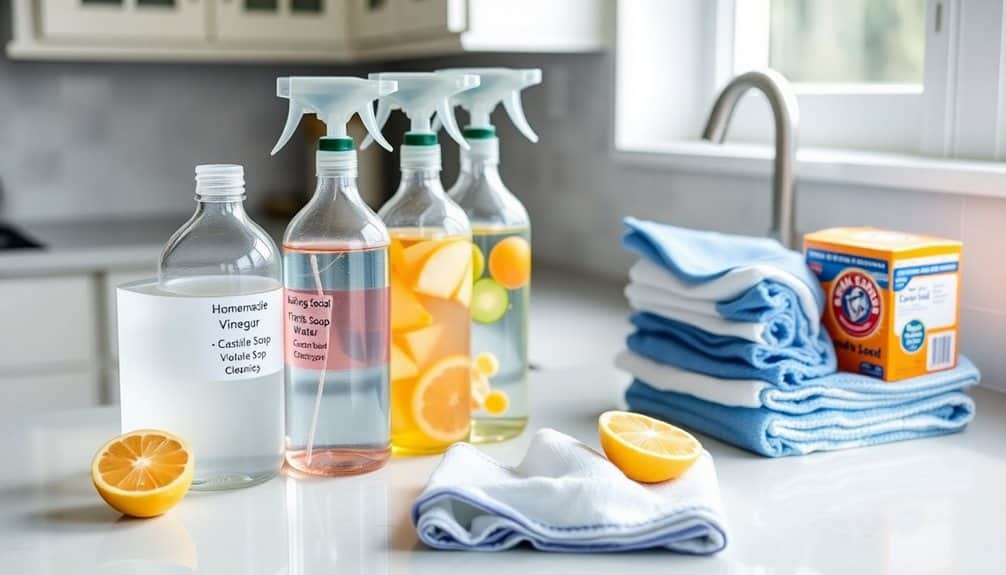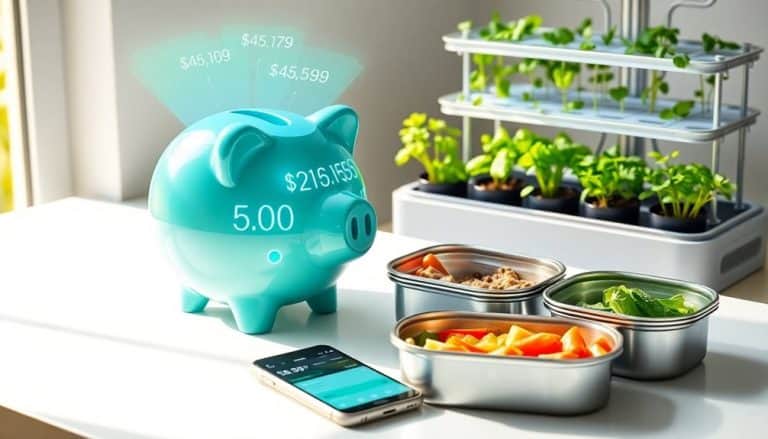This website contains affiliate links. Some products are gifted by the brand to test. As an Amazon Associate, I earn from qualifying purchases. The content on this website was created with the help of AI.
You can dramatically cut your cleaning costs by switching to DIY solutions and reusable tools. Mix your own all-purpose cleaner with water, vinegar, and tea tree oil for just $0.50 per bottle, compared to $4-6 for store brands. Replace paper towels with microfiber cloths that last hundreds of washes, and create cleaning caddies for each floor stocked with homemade products. Shop in bulk for basic ingredients like vinegar and baking soda, and track your monthly cleaning expenses to identify more savings opportunities. By implementing these smart strategies, you’ll find even more ways to reduce your household budget while maintaining a spotless home.
Key Takeaways
- Make your own cleaning solutions with vinegar, baking soda, and essential oils to save $15-20 monthly on commercial cleaners.
- Replace paper towels with reusable microfiber cloths that can be washed hundreds of times for significant long-term savings.
- Buy cleaning supplies in bulk during sales, splitting costs with neighbors or family members to maximize discounts.
- Track cleaning supply expenses for 30 days to identify unnecessary purchases and establish a strict monthly budget cap.
- Create DIY glass cleaner with water, vinegar, and rubbing alcohol instead of buying expensive commercial window cleaning products.
Make Your Own Cleaning Solutions
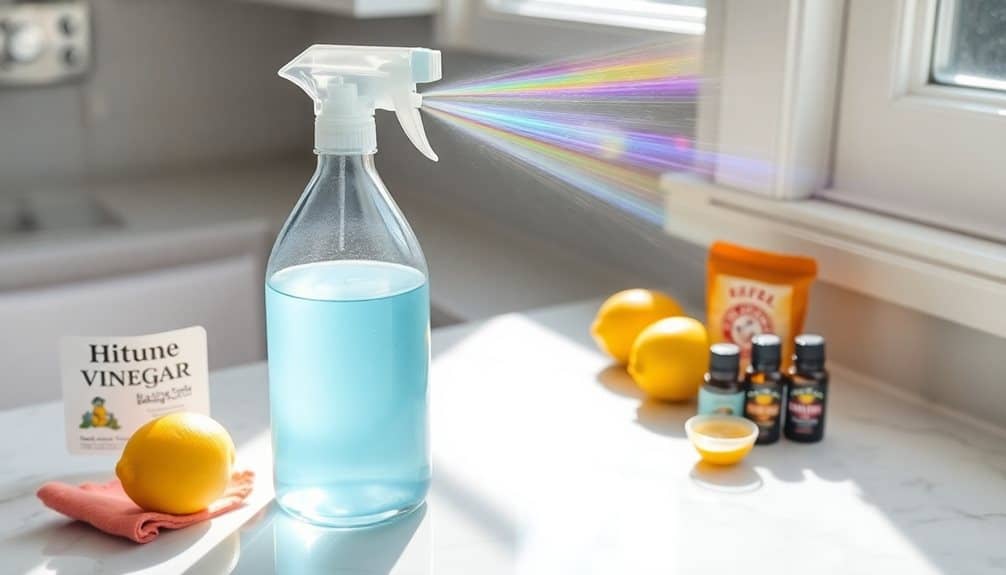
Today’s cleaning product prices can strain anyone’s budget, but making your own cleaning solutions offers a cost-effective alternative. You’ll need just a few basic ingredients: white vinegar, baking soda, lemon juice, castile soap, and essential oils. These staples cost far less than commercial cleaners and work just as effectively.
For an all-purpose cleaner, mix equal parts water and white vinegar in a spray bottle. Add 10 drops of tea tree oil for antibacterial properties. This solution costs about $0.50 per bottle compared to $4-6 for store-bought cleaners. Create a paste with baking soda and water for tough bathroom stains, or combine vinegar and baking soda for a powerful drain cleaner.
You can make glass cleaner by combining 2 cups water, 1/4 cup vinegar, and 1/4 cup rubbing alcohol. For wood surfaces, mix 1/4 cup olive oil with 1/4 cup white vinegar. A natural air freshener requires only water and essential oils. Store your homemade solutions in clearly labeled spray bottles or containers, and always test on a small area first. You’ll save approximately $15-20 monthly on cleaning supplies while avoiding harsh chemicals. Consider adding leftover citrus peels to your countertop compost bin to minimize waste while making natural cleaners.
Smart Storage for Cleaning Supplies
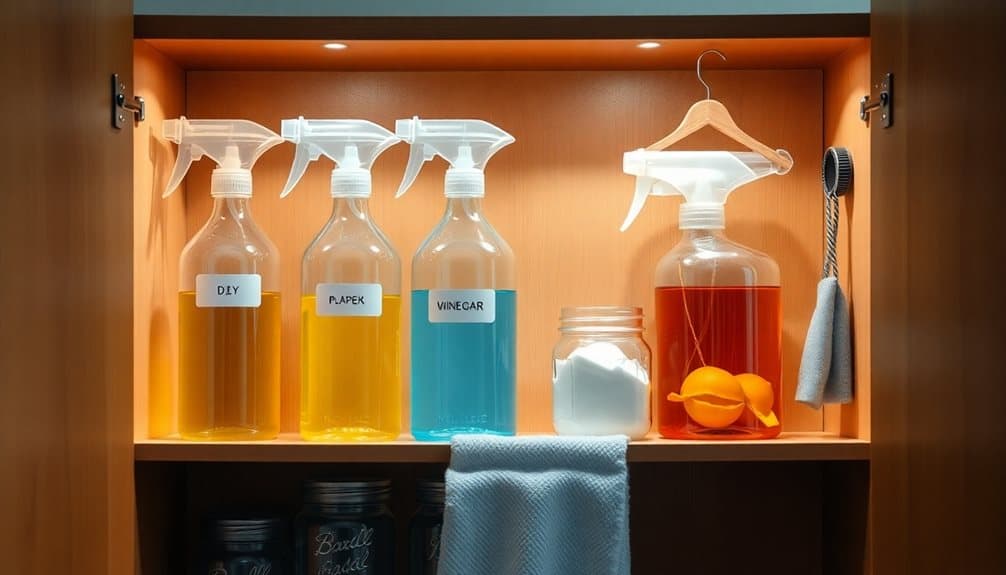
A well-organized cleaning supply storage system saves time, money, and space while preventing duplicate purchases. Start by designating specific zones in your home for cleaning supplies: one under the kitchen sink, another in each bathroom, and a main storage area in your laundry room or utility closet. Install tension rods, over-the-door organizers, and pull-out drawers to maximize vertical space.
Group similar items together using clear bins or baskets: floor cleaners, glass products, bathroom supplies, and laundry essentials. Label everything clearly, including expiration dates and safety warnings. Store frequently used items at eye level and lesser-used products on higher or lower shelves. Use a turntable or lazy Susan for small bottles to prevent items from getting lost in the back.
Create a cleaning caddy for each floor of your home, stocked with basic supplies you’ll need regularly. Keep an inventory list inside your main storage area and update it monthly. Store cleaning solutions in their original containers or clearly marked spray bottles. Don’t forget to position childproof locks on cabinets containing hazardous materials and maintain proper ventilation in storage areas. Consider installing under sink organizers to make the most of often-wasted cabinet space beneath your sinks.
Reusable Cleaning Tools

Making your cleaning supplies last longer starts with investing in high-quality reusable tools. You’ll see significant savings when you replace disposable items with durable alternatives that can withstand repeated use. Instead of paper towels, opt for microfiber cloths that you can wash and reuse hundreds of times. Swap out disposable mop pads with washable versions that’ll save you money while delivering better cleaning results.
Adding porous perlite products to your garden soil can help maintain proper drainage and aeration while keeping maintenance costs low.
Here’s what you need to create your reusable cleaning arsenal:
- Microfiber cleaning set: Purchase a color-coded set with different cloths for kitchen, bathroom, and dusting – they’ll last 2-3 years with proper care
- Machine-washable mop heads: Invest in 3-4 heavy-duty mop pads that can handle weekly washing cycles
- Refillable spray bottles: Buy 2-3 professional-grade bottles with adjustable nozzles for your homemade cleaning solutions
When maintaining your reusable tools, wash microfiber items separately from regular laundry, avoiding fabric softeners that can reduce absorbency. Air-dry your cleaning tools to extend their lifespan, and store them in a dry, ventilated area to prevent mildew growth.
Natural Alternatives to Chemical Products
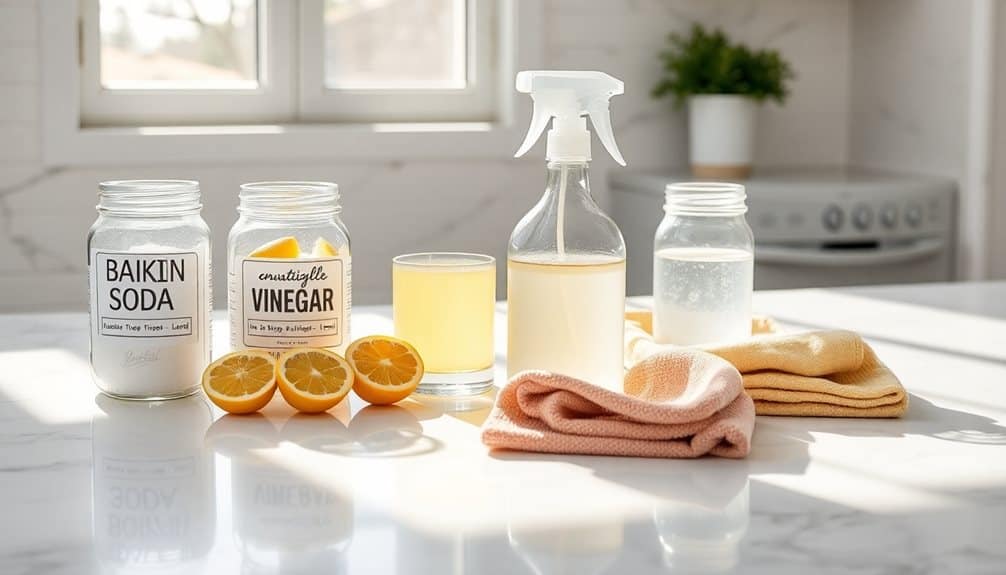
Crafting eco-friendly cleaning solutions doesn’t require expensive or harsh chemicals. You’ll find most of the ingredients you need right in your kitchen pantry. Mix equal parts white vinegar and water in a spray bottle for an all-purpose cleaner that costs less than $1 per bottle. For tough stains, create a paste using baking soda and water, which effectively scrubs surfaces without scratching.
Lemon juice serves as a natural bleaching agent and deodorizer – simply squeeze half a lemon into hot water to clean microwaves or remove sink odors. You can also combine it with salt to clean copper and brass items. For windows and mirrors, mix 2 cups of water with 1/4 cup of vinegar and 1 tablespoon of cornstarch for streak-free results.
Tea tree oil, when added to vinegar solutions (10 drops per cup), creates a powerful antifungal cleaner for bathrooms. For wooden furniture, combine 1/4 cup olive oil with 1/4 cup lemon juice to create a natural polish. These alternatives not only save money but also eliminate harmful chemicals from your home while being just as effective as commercial products.
Bulk Shopping Strategies
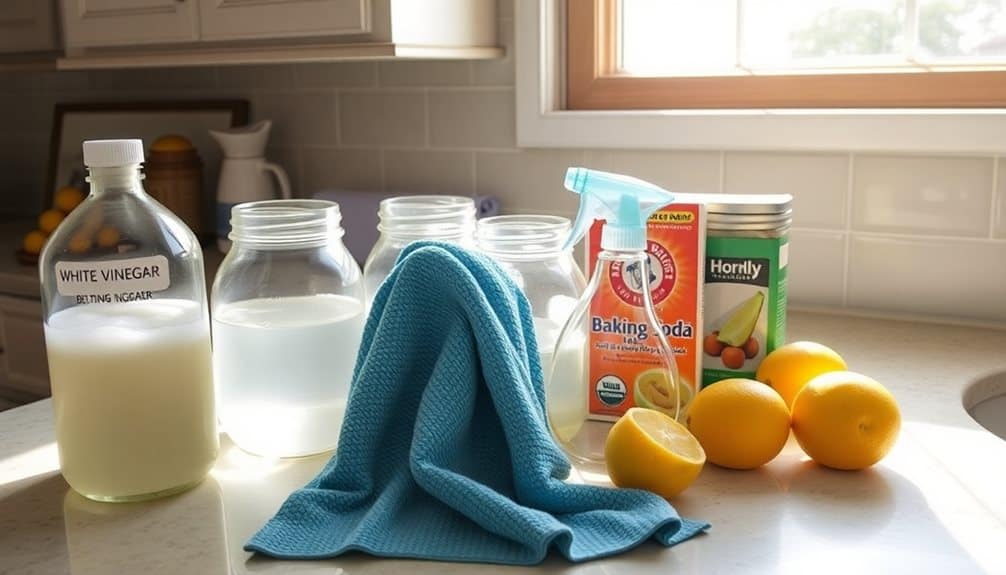
Smart bulk shopping starts with identifying your most frequently used cleaning supplies and calculating their per-unit costs. You’ll want to focus on items with long shelf lives, like vinegar, baking soda, and all-purpose cleaners. Compare prices between warehouse clubs, online retailers, and local stores to find the best deals.
Storage space plays an important role in your bulk shopping strategy. Designate a specific area in your home for cleaning supplies, and install shelving units to maximize vertical space. Before making large purchases, verify you have proper containers to store and preserve your cleaning supplies.
- Track your cleaning supply usage for one month to determine accurate quantities needed, preventing overbuying and waste
- Join multiple warehouse clubs during their free trial periods to compare prices and product quality before committing to a membership
- Partner with neighbors or family members to split bulk purchases of cleaning supplies, reducing both costs and storage requirements
When you spot exceptional deals, stock up on your essential items, but don’t exceed a six-month supply to avoid product degradation. Keep detailed records of your bulk purchases to monitor savings and adjust your strategy accordingly.
Similar to solar-powered items, cleaning supplies typically last 2-3 years when stored properly in a temperature-controlled environment.
Preventive Maintenance Tips
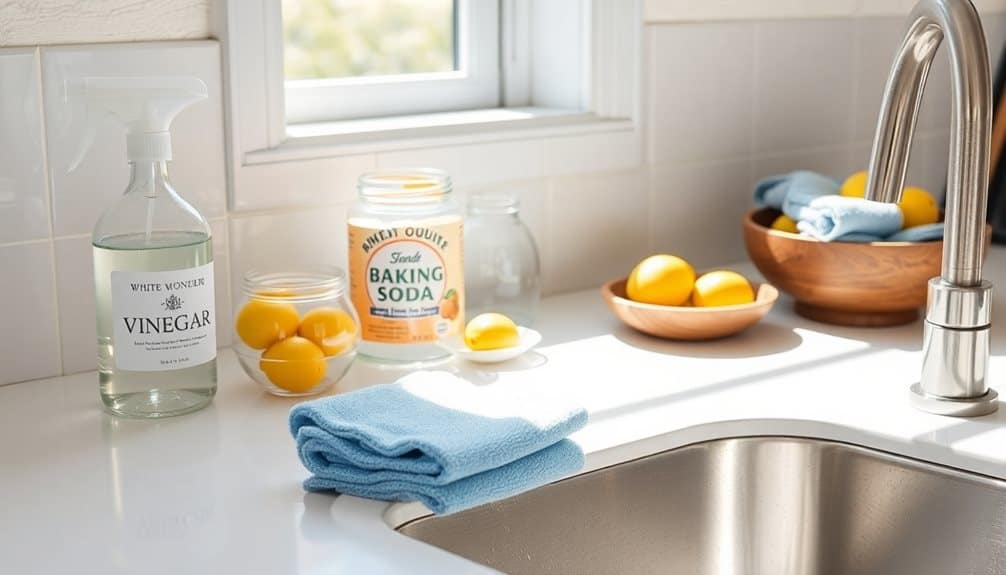
A well-planned preventive maintenance routine can reduce your long-term cleaning needs by up to 40%. Start by implementing daily micro-tasks: wipe shower walls after use, squeegee mirrors post-washing, and sweep entryways each evening. These small actions prevent buildup that leads to intensive cleaning sessions.
Install preventive solutions throughout your home. Place door mats at every entrance to catch dirt, use shower filters to prevent limescale, and apply protective coatings on frequently touched surfaces. In your kitchen, line refrigerator shelves with plastic wrap and place paper towels between non-stick pans during storage.
Schedule weekly maintenance checks for potential issues. Inspect grout lines for early signs of mold, check drain catches for debris accumulation, and monitor windowsills for moisture. Don’t forget to replace or clean your HVAC filters monthly to reduce dust circulation.
Create specific zones in your home for activities that generate mess. Designate eating areas, craft spaces, and pet stations. Use washable covers on high-traffic furniture and apply fabric protector to upholstery every six months. These boundaries help contain messes and minimize the spread of dirt throughout your living space. Following expert recommendations, perform seasonal deep cleaning every 3-4 months to prevent rust and mold accumulation in storage areas.
Monthly Budget Planning

Budgeting your cleaning supplies starts with tracking current household expenses over a 30-day period. You’ll need to document every cleaning-related purchase, from sponges to detergents, and analyze where your money’s going. By identifying spending patterns, you can spot areas where you’re overspending and find opportunities to cut costs without sacrificing cleanliness.
Create a dedicated cleaning supplies category in your monthly budget, and stick to these spending guidelines:
- Allocate 15% of your household maintenance budget to cleaning supplies, setting a firm monthly cap to prevent impulse purchases and overbuying
- Track prices across different stores using a spreadsheet or app, noting regular prices and sale cycles to optimize your purchasing timing
- Calculate the cost per use for each cleaning product by dividing the total price by the number of applications, helping you identify which products offer the best value
Review your cleaning budget every three months to adjust for seasonal needs and price changes. Don’t forget to factor in bulk purchase opportunities that might require a larger upfront investment but lead to significant long-term savings.
Frequently Asked Questions
How Long Do Homemade Cleaning Solutions Remain Effective Before They Expire?
Did you know that 83% of homemade cleaning solutions maintain their effectiveness for 3-6 months when stored properly? You’ll get the best results by keeping your DIY cleaners in dark, airtight containers away from direct sunlight and heat. Don’t make large batches – mix only what you’ll use within a month. For vinegar-based solutions, you can expect 1-2 months of potency, while baking soda mixtures last about 2 weeks once combined with liquid.
Can Mixing Different DIY Cleaning Ingredients Create Dangerous Chemical Reactions?
Never mix bleach with ammonia, vinegar, or rubbing alcohol as you’ll create toxic fumes that can cause severe respiratory issues or chemical burns. Don’t combine hydrogen peroxide with vinegar – it creates peracetic acid. Keep baking soda separate from vinegar until you’re ready to use them, as they’ll neutralize each other. Stick to simple combinations and test small amounts first if you’re unsure about mixing ingredients.
Which Cleaning Tasks Should Never Be Done With Natural Alternatives?
Picture your friend who used vinegar to disinfect a deep wound – they ended up in the ER with a severe infection. You shouldn’t rely on natural alternatives for medical-grade sanitization, biohazard cleanup, or mold remediation. These tasks require EPA-registered disinfectants to effectively kill dangerous pathogens. Don’t use DIY solutions on medical equipment, professional kitchen sanitization, or sewage cleanup – the risks aren’t worth the savings.
Are There Appliances or Surfaces That Require Specific Branded Cleaning Products?
You’ll need branded products for certain high-end appliances and surfaces. Use manufacturer-recommended cleaners for granite countertops to prevent etching and maintain the sealant. Stainless steel appliances often require specific solutions to avoid streaking and protect the finish. Electronic screens, including TVs and laptops, need designated cleaning solutions to prevent damage. Wood floors with specialty finishes typically demand brand-specific products to maintain warranty coverage.
How Do Hard Water Deposits Affect the Effectiveness of Homemade Cleaners?
Hard water deposits can reduce your homemade cleaners’ effectiveness by creating a barrier between the cleaning solution and the surface you’re trying to clean. You’ll need stronger acidic ingredients like vinegar or citric acid to break down these mineral buildups. If you’re using soap-based DIY cleaners, the calcium and magnesium in hard water will react with them, forming soap scum and reducing their cleaning power.

